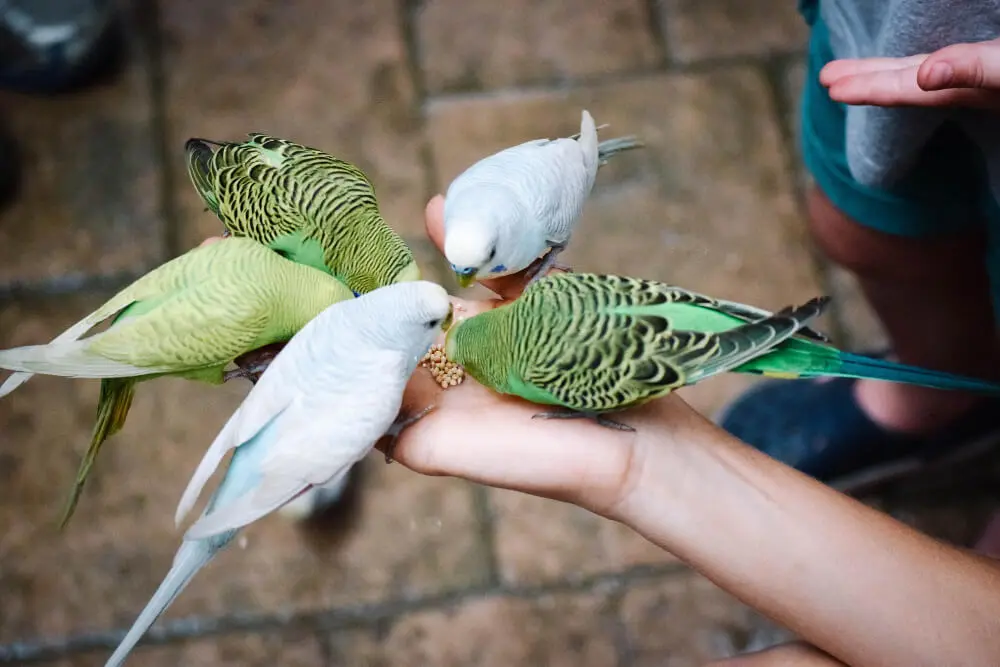Introduction
Budgerigars, commonly known as budgies, are one of the most popular pet birds around the world. Their charming personalities and vibrant plumage make them a favorite among bird enthusiasts. If you’re a budgie owner or simply fascinated by these colorful birds, understanding Budgerigar colors can be both interesting and essential.
This guide will take you through the fascinating world of Budgerigar colors. We’ll explore common colors like green, blue, yellow, and white, as well as rarer hues like albino, lutino, rainbow, and opaline. We’ll also explore the genetics behind these colors and how specific mutations create such a diverse palette.
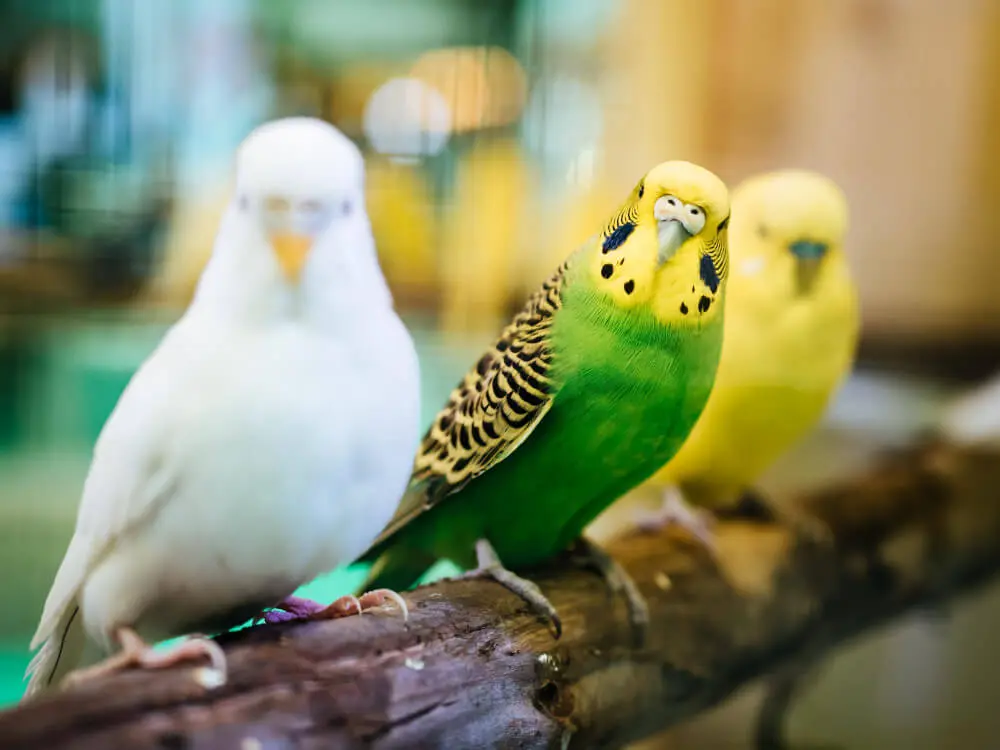
A trio of budgerigars in white, green, and yellow colors perched together, showcasing the spectrum of Budgerigar colors.
Budgerigar colors aren’t just about aesthetics; they also play a role in breeding and caring for these delightful birds. By the end of this guide, you’ll be well-versed in identifying and appreciating the myriad colors of budgerigars, making your experience as a budgie enthusiast even more enriching.
So, whether you’re looking to identify the color of your new pet, learn about the genetic background of these vibrant birds, or get tips on breeding for specific colors, this guide has got you covered. Let’s dive into the colorful world of budgerigars!
Understanding Budgerigar colors
Budgerigars, or budgies, come in an astonishing array of colors, thanks to years of selective breeding and natural mutations. From the classic green budgie to the striking albino, each color variation has its unique charm and appeal. But how do these colors come about, and what should you know about them?
Common and Rare budgie colors
Budgerigars originally come from Australia, where they are predominantly green and yellow. However, in captivity, breeders have developed many more colors, including blue, white, and even purple. Understanding these color variations can help you appreciate the beauty and diversity of budgerigars.
Common Colors: The most frequently seen budgie colors are green, blue, yellow, and white. Green is the original wild type color, while blue and yellow budgies are popular in pet stores.
Rare Colors: Colors like albino (pure white with red eyes), lutino (yellow with red eyes), and rainbow (a mix of blue, yellow, and green) are less common and often more sought after by enthusiasts.
The Role of Genetics in Budgerigar colors
The colors you see in budgerigars are a result of genetics. Specific genes determine whether a budgie will be green, blue, yellow, or any other color. For example, a single gene difference can change a green budgie into a blue one. Understanding these genetic factors can be particularly important for breeders aiming to produce specific colors.
Mutations and Color Variations
Mutations play a significant role in creating new budgerigar color varieties. A mutation can alter the pigmentation in a bird’s feathers, leading to new and unique color patterns. Over the years, breeders have capitalized on these mutations to develop budgerigars with stunning and rare colors.

Genetic chart explaining budgerigar color inheritance.
Why Color Matters
Color isn’t just about looks; it can also indicate a budgie’s health and genetics. Some colors might require special care, and understanding the genetics behind your budgie’s color can help you better care for your feathered friend. For example, albino and lutino budgies can be more sensitive to sunlight due to their lack of pigment.
In this guide, we’ll explore these colors in more detail, helping you identify and appreciate the full spectrum of Budgerigar colors. Whether you’re a new budgie owner or a seasoned breeder, knowing about these color variations will enhance your experience with these delightful birds.
Common Budgerigar colors
Budgerigars, often simply called budgies, are known for their vibrant and varied colors. These colorful feathers not only make them beautiful pets but also a fascinating subject for bird enthusiasts. Let’s explore some of the most common Budgerigar colors you might encounter.
Green
Green is the original color of wild budgerigars found in their native habitat in Australia. This vibrant color helps them blend into their natural surroundings, offering camouflage against predators. Green budgies have yellow faces and black barring on their wings and back, creating a striking contrast. This classic color remains a favorite among budgie owners.
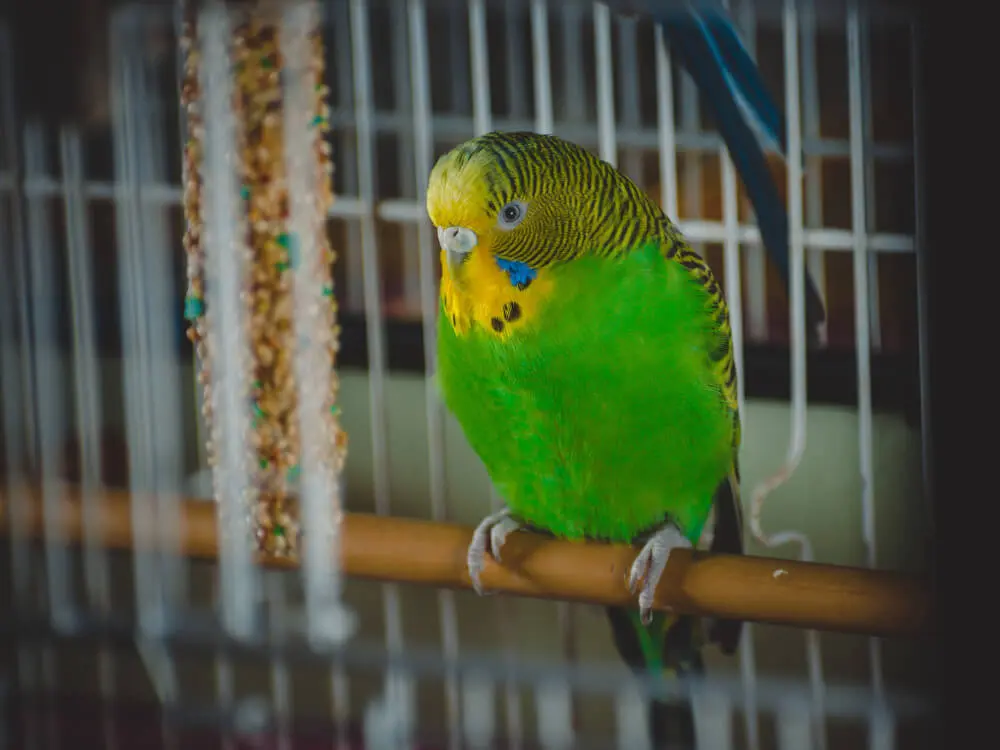
A green budgerigar enjoys its time inside a cage filled with colorful toys, reflecting the bird’s playful nature.
Blue
Blue budgerigars are a popular choice for many pet owners. They come in various shades, from light sky blue to deep cobalt. Blue budgies typically have white faces and lack the yellow pigmentation found in their green counterparts. The combination of blue feathers and white faces gives these birds a serene and pleasing appearance.
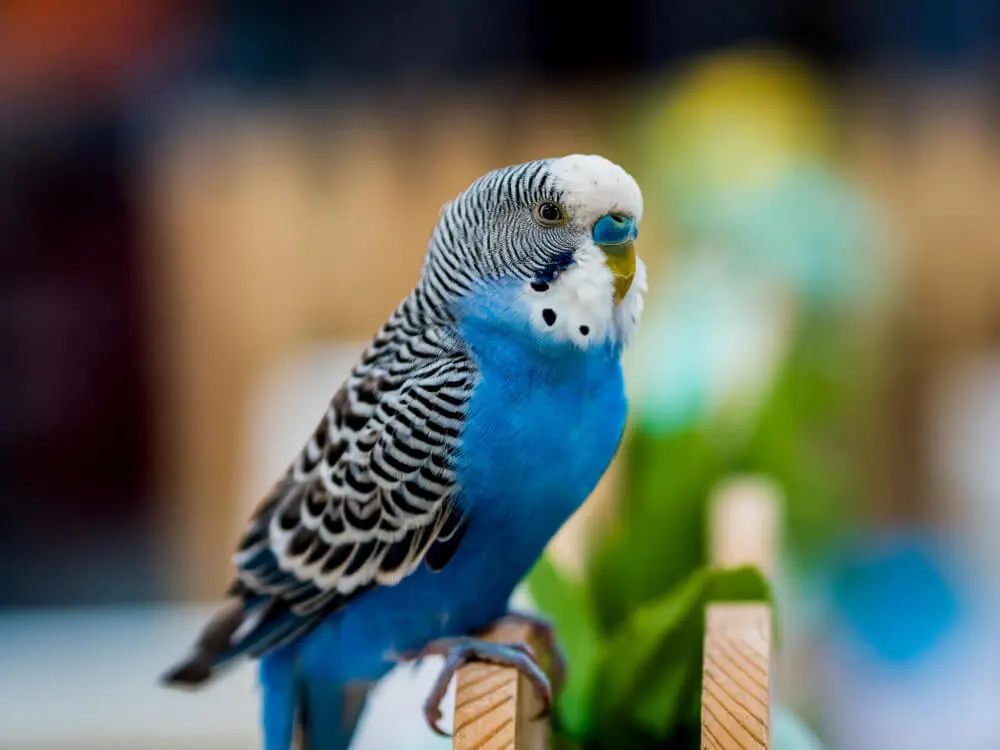
A blue budgerigar perched confidently on a wooden stand, showcasing its vivid blue plumage.
Yellow
Yellow budgerigars, often called lutinos when they have red eyes, are another common and eye-catching variety. These birds have bright yellow feathers and can appear almost golden in the right light. Yellow budgies often have pale or white faces, and their vibrant color makes them a standout choice for any bird lover.
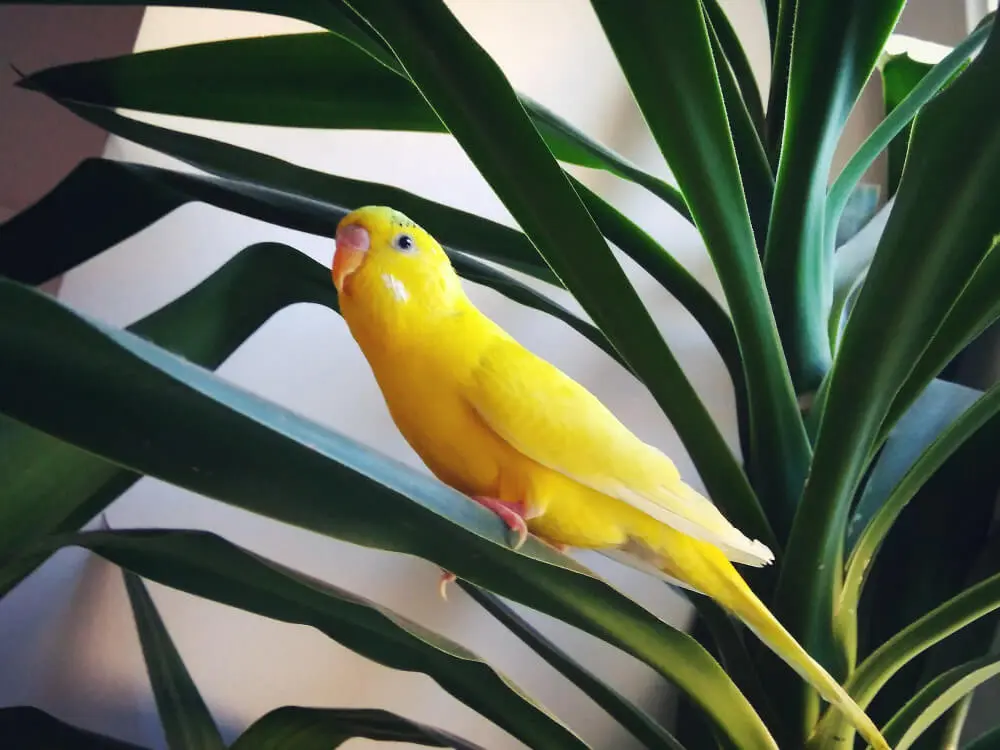
A vibrant yellow budgerigar rests gracefully on lush green plant leaves, showcasing its bright plumage.
White
White budgerigars, especially albinos, are known for their striking appearance. Pure white feathers combined with red or dark eyes give these birds a unique and elegant look. Albino budgies, with their lack of pigmentation, are particularly sensitive to light and may require special care to keep them comfortable and healthy.

A white budgerigar sits calmly on a perch, with a group of colorful budgerigars in the background.
Combining Colors
Sometimes, budgerigars exhibit a mix of these common colors, resulting in beautiful combinations. For example, a budgie might have a green body with blue highlights or a yellow face with a blue body. These color mixes add to the charm and uniqueness of each bird.
Understanding these common Budgerigar colors can help you appreciate the beauty and diversity of these wonderful pets. Whether you’re choosing your first budgie or adding to your flock, recognizing these colors will enhance your experience and connection with these vibrant birds.
Rare and Unique Budgerigar colors
While common Budgerigar colors are a delight to behold, rare and unique budgie colors add an extra layer of fascination for bird enthusiasts. These colors often result from specific genetic mutations and selective breeding, making them a sought-after choice for collectors and breeders alike. Let’s explore some of these extraordinary Budgerigar colors.
Albino
Albino budgerigars are entirely white with striking red eyes, a result of a lack of pigmentation. This rare color mutation gives them a ghostly yet elegant appearance. Albino budgies are particularly sensitive to sunlight due to their lack of melanin, requiring owners to be mindful of their exposure to bright light. Despite their delicate nature, albino budgies are captivating and truly stand out in any aviary.
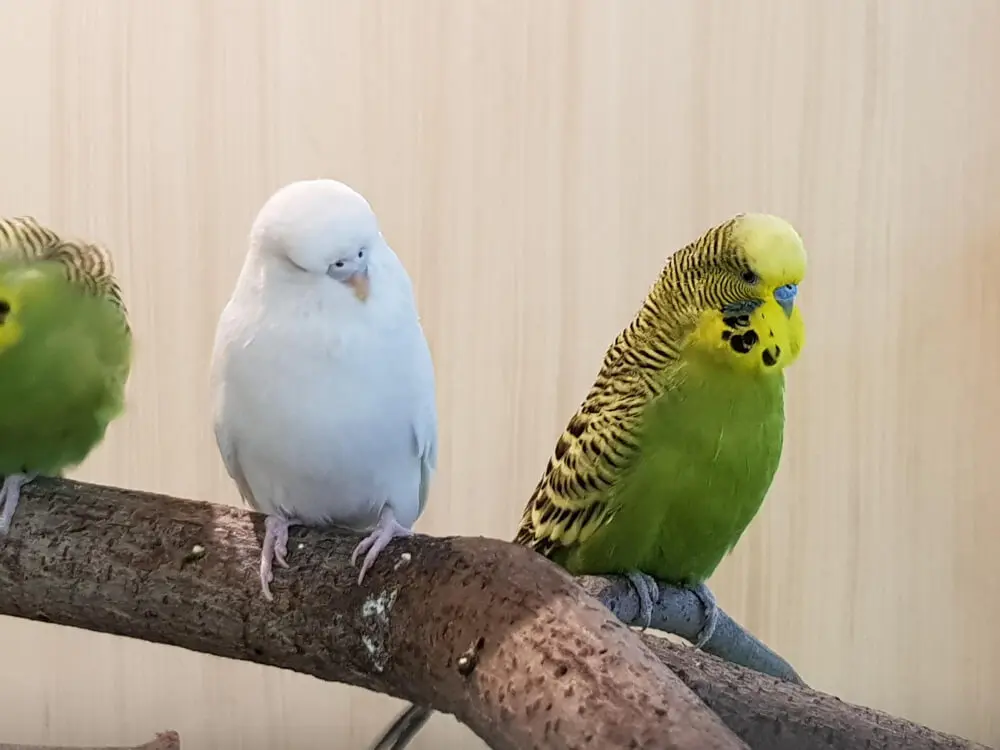
A green budgerigar and a white budgerigar share a branch, illustrating the contrasting colors found in budgerigars.
Lutino
Lutino budgerigars are a stunning yellow variant with red eyes, similar to albinos but with yellow feathers. This vibrant color is the result of a specific mutation affecting pigment production. Lutino budgies have an unmistakable golden hue, making them one of the most visually striking and desirable Budgerigar colors. Their bright plumage and gentle demeanor make them a favorite among budgie enthusiasts.

A yellow budgerigar stands out in a cage filled with variously colored budgerigars, demonstrating the color diversity in budgerigars.
Rainbow
Rainbow budgerigars are one of the most colorful and visually appealing varieties. As their name suggests, these budgies display a mix of blue, yellow, and green feathers, often with intricate patterns and shades that resemble a rainbow. The combination of colors is achieved through careful breeding, making rainbow budgies relatively rare and highly sought after. Their vibrant and unique appearance never fails to impress.

A rainbow budgerigar enjoys a millet snack, highlighting the natural diet of budgerigars.
Opaline
Opaline budgerigars are known for their distinctive feather patterns and unique coloration. This mutation changes the typical black barring on the wings and back to a lighter shade, often resulting in a softer, more blended appearance. Opaline budgies can come in various colors, including blue, green, and yellow, with a pearlescent quality that makes them stand out. Their subtle beauty and rare pattern make them a prized addition to any budgie collection.
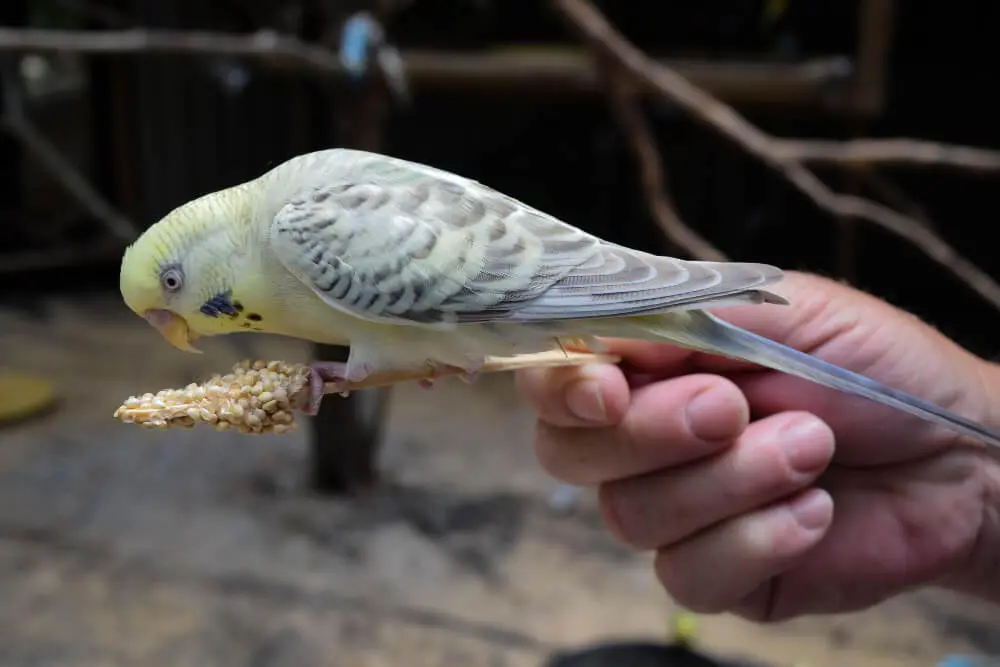
A opaline budgerigar perches on a hand and eats
Spangle
Spangle budgerigars have a unique feather pattern that makes them easily recognizable. Instead of the usual black bars, spangle budgies have light-colored or white bars edged with dark colors. This reverse pattern creates a striking visual effect, especially when combined with bright base colors like blue or yellow. Spangle budgies are relatively rare and highly prized for their distinctive and eye-catching appearance.

Spangle budgerigar perched on floor
Understanding these rare and unique Budgerigar colors can enhance your appreciation for these incredible birds. Whether you’re a breeder aiming to produce these special colors or simply a budgie lover wanting to learn more, recognizing these unique variations adds depth to your knowledge and enjoyment of budgerigars.
How Budgerigar colors Develop
The vibrant and varied colors of budgerigars are a result of complex genetic processes. Understanding how these colors develop can enhance your appreciation for these beautiful birds and provide insights into their care and breeding.
Genetics of Budgerigar colors
At the core of budgerigar color development is genetics. Each budgie’s color is determined by specific genes inherited from its parents. These genes control the presence and distribution of pigments in the feathers. There are two primary pigments involved in budgerigar coloration: eumelanin, which produces dark colors like black and brown, and psittacofulvin, which produces bright colors like yellow and red.
Color Mutations and Their Effects
Mutations play a significant role in creating the diverse palette of Budgerigar colors. A mutation can alter the production or distribution of pigments, leading to unique color variations. For example, a mutation that affects the production of eumelanin can result in blue budgies, while a mutation that influences psittacofulvin can produce yellow or albino budgies.
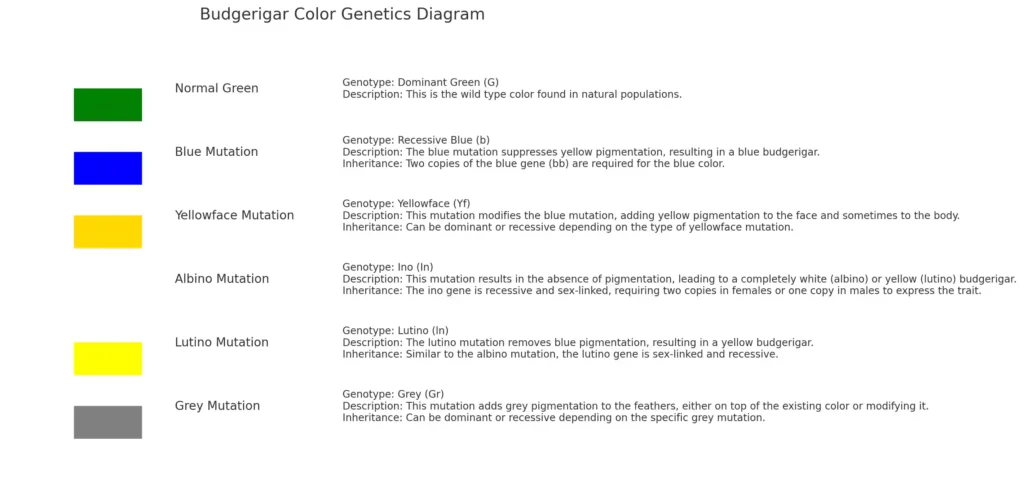
A detailed diagram explaining the genetic mutations responsible for various Budgerigar colors.
Common Genetic Variations
Green and Yellow: In wild budgerigars, the green color is dominant. This is because green is a combination of yellow psittacofulvin and blue structural coloration. Yellow budgies, known as lutinos when they have red eyes, result from a mutation that prevents the production of eumelanin, leaving only the yellow pigment.
Blue and White: Blue budgies lack the yellow pigment due to a mutation that affects psittacofulvin production. As a result, the underlying blue structural color becomes visible. White budgies, especially albinos, lack both pigments, resulting in a pure white appearance.
The Role of Breeding
Selective breeding is a key factor in developing and maintaining specific Budgerigar colors. Breeders carefully choose parent birds with desired traits to produce offspring with particular colors. Understanding the genetics behind these colors allows breeders to predict and achieve specific outcomes, whether they aim for common colors like green and blue or rare varieties like rainbow and opaline.
Special Considerations for Rare Colors
Rare Budgerigar colors, such as albino and lutino, require special care due to their unique genetic makeup. For instance, albino budgies, with their lack of pigmentation, are more sensitive to sunlight and may need protection from direct exposure. Understanding these needs is crucial for ensuring the health and well-being of these birds.
In conclusion, the development of Budgerigar colors is a fascinating interplay of genetics and selective breeding. By understanding the genetic basis of these colors, budgie enthusiasts can better appreciate the diversity and beauty of these charming birds. Whether you’re a breeder or a pet owner, knowing how Budgerigar colors develop can deepen your connection with these vibrant creatures.
Caring for Budgerigars Based on Their Color
Caring for budgerigars involves understanding their unique needs, which can sometimes vary based on their color. Different budgie colors can indicate specific genetic traits that may affect their care requirements. Here’s a guide to help you provide the best care for your colorful feathered friends.
General Care Tips for All Budgerigars
Regardless of color, all budgerigars need a balanced diet, a clean and safe environment, and regular social interaction. Ensure they have access to fresh water, a variety of seeds, fruits, and vegetables, and toys for mental stimulation. Regular vet check-ups are also essential to keep your budgie healthy.
Special Considerations for Albino and Lutino Budgerigars
Albino and lutino budgerigars, with their lack of pigmentation, are particularly sensitive to sunlight. Their red eyes can be more prone to light sensitivity, so it’s important to protect them from direct sunlight. Providing shaded areas in their cage and avoiding exposure to bright light can help keep them comfortable.
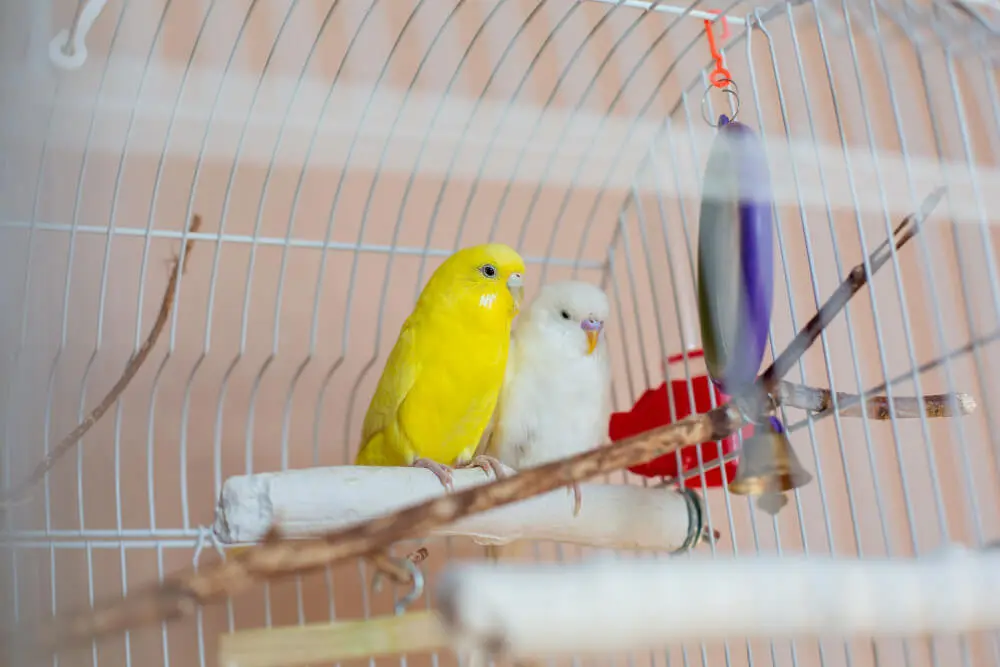
A bright yellow budgerigar and a white budgerigar perch together in a cozy birdcage.
Caring for Blue and White Budgerigars
Blue and white budgerigars, including albinos, may have different dietary requirements due to their genetic makeup. These budgies can sometimes have weaker immune systems, making them more susceptible to illnesses. Ensure they have a nutritious diet rich in vitamins and minerals to boost their immune health. Adding supplements as recommended by a vet can also be beneficial.
Caring for Rainbow and Opaline Budgerigars
Rainbow and opaline budgerigars are known for their vibrant and varied colors, which result from specific genetic mutations. These birds often have the same care requirements as other budgies, but their unique patterns make them especially prone to feather issues. Regular grooming and monitoring for any feather abnormalities are essential to keep them looking their best.
Monitoring Health Based on Color Indicators
The color of your budgerigar can sometimes give you clues about their health. For example, changes in feather color or pattern can indicate nutritional deficiencies or health issues. Regularly checking your budgie’s feathers for any changes can help you catch potential problems early and seek veterinary advice when needed.
Creating a Comfortable Environment
Different budgie colors may require adjustments to their living environment. For instance, budgies with lighter colors may benefit from cages that provide ample shade and hiding spots to reduce stress. Ensuring that the cage is spacious and has varied perches and toys can also help cater to the needs of budgies with different activity levels and temperaments.
Understanding the specific needs of your budgerigar based on their color can enhance their well-being and longevity. By providing tailored care that considers their unique genetic traits, you can ensure that your colorful companion remains happy and healthy. Whether you have a common green budgie or a rare rainbow variety, knowing how to care for them properly will strengthen your bond and keep your feathered friend thriving.
Breeding Budgerigars for Specific Colors
Breeding budgerigars to achieve specific colors is both an art and a science. By understanding the genetics behind budgie colors and using selective breeding techniques, you can increase the likelihood of producing budgies with your desired color traits. Here’s a comprehensive guide to help you breed budgerigars for specific colors effectively.
Understanding Budgerigar Genetics
To breed budgerigars for specific colors, it’s crucial to understand the basic genetics involved. budgie colors are determined by genes that control the production and distribution of pigments. Some colors are dominant, while others are recessive, affecting how these traits are passed from parents to offspring.
Choosing the Right Breeding Pairs
Selecting the right breeding pairs is the first step towards achieving specific colors. When choosing budgies for breeding:
1. Know Their Genetic Background: Understanding the genetic history of your budgies helps predict the color outcomes. This includes knowing if they carry recessive genes that might not be visible in their phenotype but can appear in their offspring.
2. Pair Complementary Colors: For example, to produce blue budgies, pair birds that either show the blue color or carry the blue gene. Pairing a green budgie with a blue one can result in both green and blue offspring, depending on their genetic makeup.
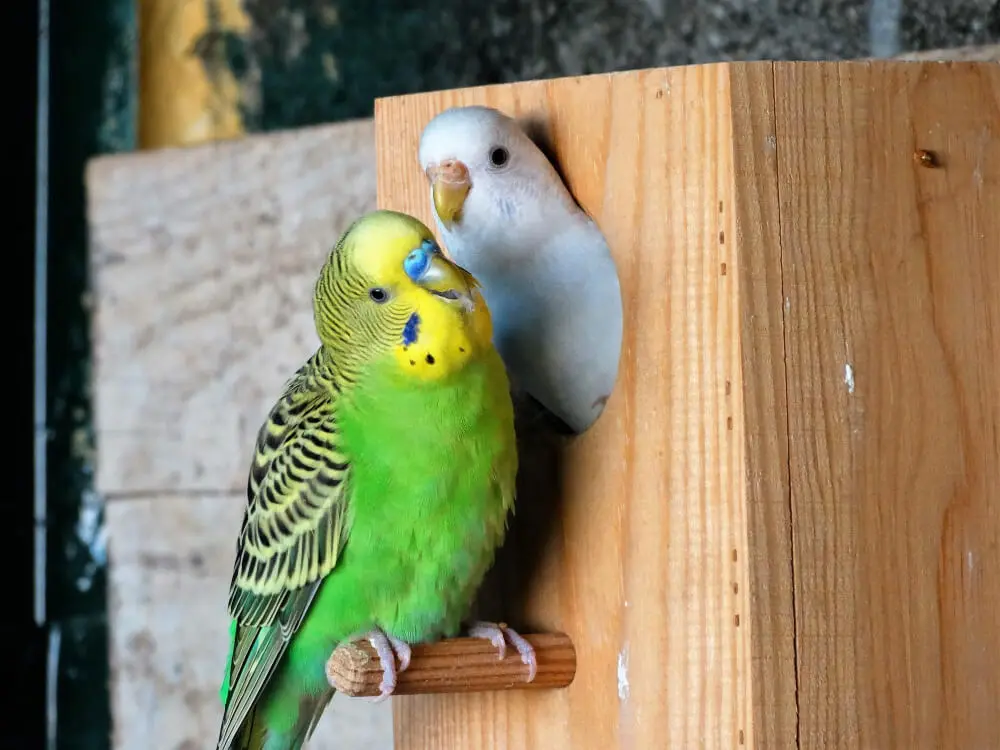
A beautiful green budgerigar and a white budgerigar share a wooden perch.
Common Breeding Goals
Breeding for Blue Budgerigars: To breed blue budgies, pair two blue birds or a blue bird with a green bird that carries the blue gene. Blue is a recessive trait, so both parents must carry the gene for blue offspring.
Breeding for Albino and Lutino Budgerigars: Albino and lutino budgies require both parents to carry the ino gene. Pairing two lutinos or two albinos will produce offspring with these colors. Albino budgies are white with red eyes, while lutino budgies are yellow with red eyes.
Breeding for Rainbow Budgerigars: Rainbow budgies result from a combination of blue, yellowface, and opaline genes. Carefully selecting budgies that exhibit these traits and understanding their genetic background is essential for achieving this vibrant mix of colors.
Breeding Process
1. Set Up a Breeding Environment: Provide a comfortable and safe breeding environment. This includes a spacious cage, nesting boxes, and a nutritious diet rich in seeds, fruits, and vegetables.
2. Monitor Mating and Egg Laying: Once the breeding pair is introduced, monitor them closely for signs of mating. After successful mating, the female will lay eggs, which usually hatch in about 18 days.
3. Care for the Chicks: Ensure the chicks are well-fed and cared for after hatching. This involves providing the parents with enough food to feed their young and keeping the environment clean and safe.
Record Keeping and Patience
Keeping detailed records of your breeding pairs and their offspring is essential for tracking genetic traits and making informed decisions in future breeding efforts. Breeding for specific colors can require patience, as it may take several generations to achieve the desired results consistently.
Ethical Considerations
While breeding for specific colors can be rewarding, it’s important to consider the health and well-being of the birds. Avoid inbreeding and ensure that your breeding practices prioritize the budgies’ health over aesthetic traits.
Breeding budgerigars for specific colors is a fascinating endeavor that combines genetic knowledge with careful planning and patience. By understanding the principles of budgie genetics and selecting the right breeding pairs, you can achieve a variety of beautiful and unique budgie colors. Whether you’re aiming for common colors like blue and green or rare ones like albino and rainbow, following these guidelines will help you succeed in your breeding efforts.
Frequently Asked Questions About Budgerigar colors
Understanding the myriad colors of budgerigars can be fascinating but also raises many questions. Here are some frequently asked questions about Budgerigar colors to help you better appreciate and care for your colorful feathered friends.
How to Identify the Color of Your Budgerigar?
Identifying your budgerigar’s color involves observing its feather patterns and shades. Common colors include green, blue, yellow, and white. Look for specific markers like the color of the face, the presence of barring on the wings, and the hue of the body feathers. For more unique colors like albino or lutino, check for distinguishing features such as red eyes and the absence of pigmentation.
Do Budgerigar colors Affect Their Health?
Generally, the color of a budgerigar does not directly affect its health. However, certain rare colors, like albino and lutino, may have specific needs. For instance, albino budgies are more sensitive to sunlight due to their lack of pigmentation, which requires special care to protect their delicate eyes. Ensuring a balanced diet and proper care is essential for all budgies, regardless of color.
Can You Predict the Color of Budgerigar Offspring?
Yes, you can often predict the color of budgerigar offspring by understanding the genetics of the parent birds. Knowing whether the parents carry dominant or recessive color genes helps in predicting the potential colors of the chicks. For instance, pairing two blue budgies increases the likelihood of blue offspring, while mixing colors like green and blue can result in a variety of shades depending on the genetic makeup.
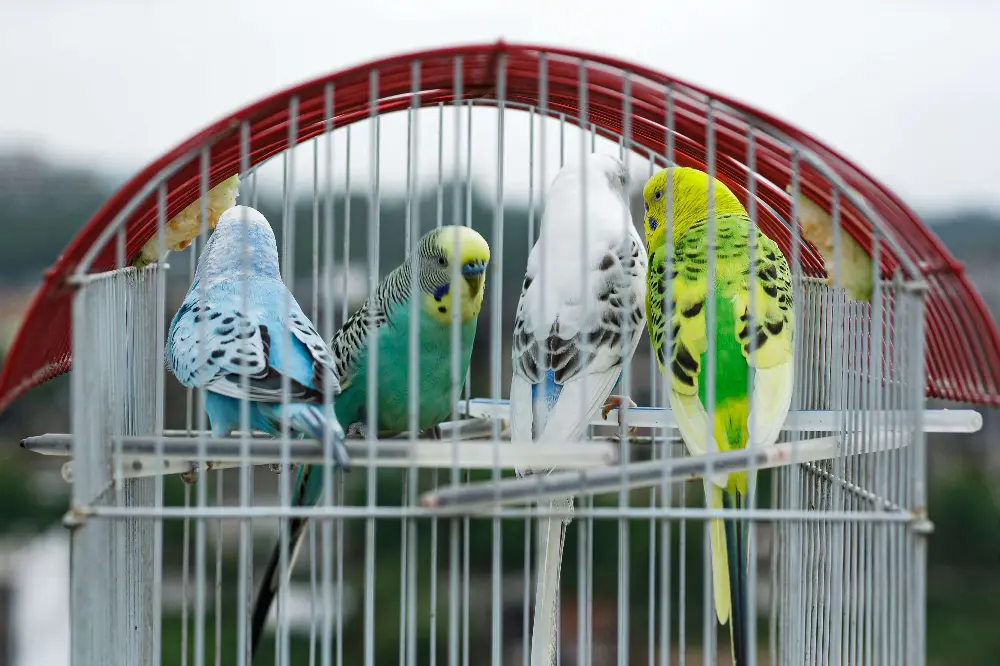
A cage containing four budgerigars displaying a range of colors from blue to yellow and green.
What Are the Rarest Budgerigar colors?
Some of the rarest Budgerigar colors include albino, lutino, rainbow, and opaline. These colors result from specific genetic mutations and are less common in the wild. Breeding for these rare colors requires a deep understanding of budgie genetics and careful selection of breeding pairs.
How Do Mutations Affect Budgerigar colors?
Mutations can significantly affect Budgerigar colors by altering pigment production and distribution. These genetic changes can lead to unique and rare color variations, such as the spangle pattern or the opaline trait. Breeders often take advantage of these mutations to create visually striking budgerigars.
Can Budgerigar colors Change Over Time?
Budgerigar colors generally remain consistent throughout their lives, but there can be slight changes during molting periods. During molting, new feathers might appear slightly different in shade, but the overall color pattern typically stays the same. Significant color changes may indicate health issues or nutritional deficiencies and should be checked by a vet.
Is It Possible to Breed Budgerigars for a Specific Color?
Yes, breeding budgerigars for specific colors is possible and commonly practiced by breeders. By understanding and applying genetic principles, breeders can pair budgies to produce desired colors. This involves selecting parents with the right genetic traits and monitoring the breeding outcomes over several generations.
Why Are Some Budgerigar colors More Expensive?
Some Budgerigar colors are more expensive due to their rarity and the complexity involved in breeding them. Colors like albino, lutino, and rainbow require specific genetic combinations and careful breeding practices, making them more valuable and sought after by enthusiasts.
Do Different Budgerigar colors Have Different Personalities?
While Budgerigar colors are primarily a result of genetics and don’t directly influence personality, individual birds can have unique temperaments. Factors like upbringing, environment, and socialization play a more significant role in shaping a budgie’s personality than its color.
Budgerigar colors are a fascinating aspect of these delightful birds, offering a wide range of hues and patterns to enjoy. By understanding the genetics, care requirements, and breeding practices associated with budgie colors, you can better appreciate and care for your feathered friends. Whether you have a common green budgie or a rare rainbow variety, each color brings its own charm and beauty.
Conclusion
Budgerigar colors are more than just a visual delight; they reflect the rich genetic tapestry and careful breeding practices that have shaped these vibrant birds. From the common green and blue to the rare and unique albino and rainbow varieties, each budgie color has its own story and charm. Understanding how Budgerigar colors develop, their genetic background, and the specific care each color may require can enhance your experience as a budgie owner or breeder.
By appreciating the diversity of Budgerigar colors, you can make informed decisions about breeding, care, and selection. Whether you’re drawn to the striking appearance of a lutino budgie or the gentle elegance of an albino, knowing more about these colors helps you provide the best environment and care for your feathered friends.
As you continue to explore the world of Budgerigar colors, remember that each bird, regardless of its hue, brings joy and companionship. Their colors are just one aspect of their delightful personalities and the happiness they bring into our lives. Embrace the variety, enjoy the beauty, and cherish the bond you share with your colorful companions.
References and Further Reading
To explore deeper into the fascinating world of Budgerigar colors, genetics, and care, here are some valuable resources and references. These sources will provide you with a more comprehensive understanding and additional insights into the colorful lives of budgerigars.
Books
1. “Budgerigar Matings and Colour Expectations” by F. S. Elliott
This book is a comprehensive guide to understanding the genetics of budgerigar breeding and predicting the resulting color variations.

The cover of F.S. Elliott’s book “Budgerigar Matings and Colour Expectations,” a classic reference on Budgerigar colors.
2. “Budgerigars: A Guide to Caring for Your Parakeet” by Angela Davids
A comprehensive guide that includes information on identifying and caring for various budgie colors.

The cover of Angela Davids’ book “Budgies: A Guide to Caring for Your Parakeet,” featuring a green budgerigar.
Websites
1. Budgerigar Council of South Australia (BCSA) – (https://bcsa.com.au)
An extensive resource on budgie care, including detailed articles on Budgerigar colors and genetics.
2. The Budgerigar Society – (http://www.budgerigarsociety.com)
Official site with information on budgie breeding, genetics, and color mutations.
Online Forums and Communities
1. Talk Budgies Forum – (http://www.talkbudgies.com)
A vibrant online community where budgie enthusiasts share experiences, advice, and information on budgie colors and care.
2. Budgie World Facebook Group
Join this group to connect with other budgie owners and breeders, and discuss color variations and care tips.

